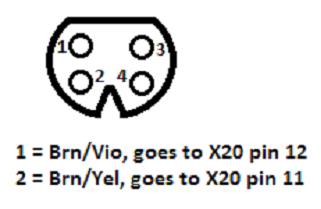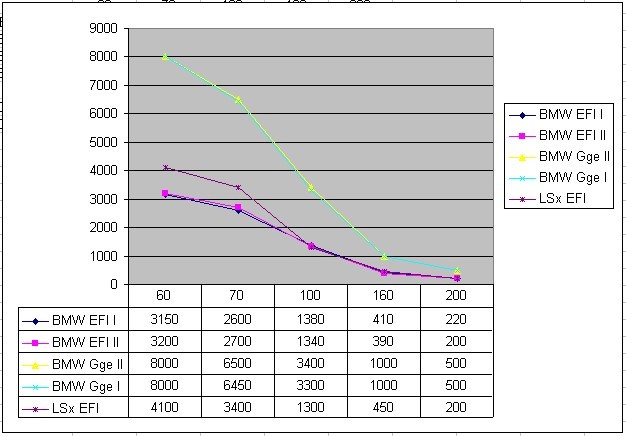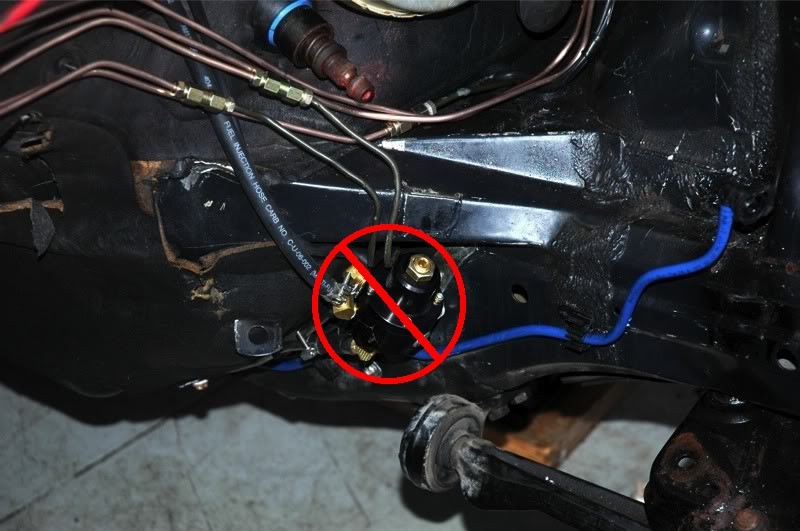You must be logged in to rate content!
7 minute(s) of a 105 minute read
8-1-2010
Been a couple months, about time for an update…
I’m still alive, gaining a little weight, getting older, and still married. Oldest daughter graduated high school, she also got her drivers license and has commandeered my only mode of transportation. Summer weather has been real mild, actually sort of a weird summer weather wise. Our annual camp-in this year was fantastic, thank you to all that came out. The dusty hulk of steel that is close to being evicted, running or not, is still in the shop and on jack stands.
Water temp sendors AND sensors, BMW EFI, BMW Gauge and LSx, measured, (Senders and sensors tested were BMW BOSCH connection/square 2 prong; Black top, Green Top, Brown/Tan top, 4 prong prong round top, early Datsun EFI and GM LSx. Of interesting note is that all the BMW 2 prong EFI and Datsun EFI sensors were within 2% of each tother from 60-20 degrees F).
First the good news.
The resistance values-vs-temp values for the instrument gauges on ALL E36 cars, '92-'99 are the same! We all have been speculating they were different, come to find out they aren’t. BMW originally utilized two separate sensors/senders, (one for the EFI, other for the gauge), on the ’92-’95 cars then in ‘96 combined them into one housing for the later cars, the 4 prong sensor/sender and retained the same exact values for both DME and gauge. :buttrock
Now the great news! :alright
What that means for anyone doing the 92-’99 E36, (318, 323, 325, 328, M3,) LSx conversion is the ’96+ 4 prong sensor/sender works with their gauge and threads directly into the LSx head, no drilling, tapping, bushings, adapters etc to use the earlier 2 prong sensor, unless you want to. :confused Just deduce which 2 prongs for the gauge, (easy to do with the Bentley manual and an OHM meter), and you’re there.
As for the pig tail, many other BMW’s used this same connector, easy to find in wrecking yards on other cars.
Quote:
Originally Posted by bimerok  Here are the pins to use (Looking at the connector's end. X20 pins based on 1996 328is):
Here are the pins to use (Looking at the connector's end. X20 pins based on 1996 328is):
Connector Part # 12521703571 - Need One
Connector Pins # 61130007657 - Need Two (usually comes with short wire and seal)
The just ho-hum news.
The LSx PCM sensor has a slightly different curve/slope compared the BMW EFI temps sensor, enough so that you wont want to use the BMW DME sensor for the LSx PCM, (see chart below). One could possibly adjust the CLT values using one of the tuning suites, I am pretty sure it’s just easier to install the GM temps sensor in the other head and be done with it. For what it’s worth, ALL GM temp sensors coolant and air temp have the same resistance to temp values, across the board, Pontiac, Olds, Chevrolet, etc, applicable to all GM Multi Port EFI vehicles.
LEGEND!
X axis= Degrees Fahrenheit.
Y axis = resistance in OHMS.
BMW EFI I = OBD-I DME temp sensor.
BMW EFI II = OBD-II DME temp sensor.
BMW Gge I = OBD-I gauge temp sender.
BMW Gge II = OBD-II gauge temp sender.
LSx EFI = PCM temp sensor.

There seems to be a down side to these BMW temp gauges. I spent a bit of time researching this and here is what I found.
BMW incorporated some form of buffer within the instrument cluster itself that holds the temp needle straight up, middle of the gauge when the engine is between 140-230ish degrees F. If the coolant temp breaches 230-ish then the gauge will swing from the middle up to HOT, not an incremental climb as one would expect or hope for as the engine gets warmer. The sender itself is analog like any other sender for a temp gauge, this buffering is done in the instrument cluster. Some feel the Euro cluster has less of a buffer but I was not able to find any evidence to support or deny that claim. There is a bit of speculation as to why BMW did this, turning a perfectly useful analog gauge into useless cold hot dial, beneficial no one. (theories such a people are getting so stupid that when they wee gauge move from center they panic and take their car to the dealer so this prevents unnecessary warranty claims, etc). Regardless, I see no point in trying to figure out why BMW did this, it is what it is, any discussion should really be centered around a possible solution to obtain a true analog temp gauge. Some have talked about trying to remove the buffer in the instrument itself, others have successfully replaced the internal guts of the temp gauge with VDO guts, stock needle and now have a gauge that indicates temperature on an analog scale. If someone finds a way to eliminate the buffer itself or other way so to get around this, please share, for now, here is what I found;
The issue, for those interested in reading;
http://forums.bimmerforums.com/forum....php?t=1208832
http://forums.bimmerforums.com/forum....php?t=1480682
http://m3forum.net/m3forum/showthread.php?t=324399
Fixes;
http://forums.bimmerforums.com/forum....php?t=1105631
http://forums.bimmerforums.com/forum...d.php?t=776813
I tried to verify this “buffer” thing in my car using a 0-10k potentiometer, (Variable resistor), no joy. I think I may to finish up more of the wiring before my instrument cluster will allow the temp gauge to function?!
In other recent news, received a set of prototype headers to mock up in the car in hopes of finalizing placement of the engine mounts, headers need a bit of work still, we are still up in the air on actual mount design/placement. Though with these headers mocked up I did learn that my choice for location of the Mallory Fuel Pressure Regulator was a poor choice. Headers were within 1/8” to 1/4” of the FPR. Removed the FPR and installed the Corvette FPR/filter in place of the OE BMW filter and all is well now. Connected the battery, (it still has power, even after sitting for over a year!) pressurized the fuelsystem, fuel pressure is right at 59-60 PSI. Probably should consider ordering another pump to have on hand in case this one dies once I get it on the road. Car had 19x,xxx miles when I put up on jackstands over a year ago, no idea how many miles on this pump and probably shouldn’t trust it especially after sitting for so long and then ramping up the fuel pressure by 33%.

Another note for those of you using the Vette FPR, be aware that if your PCM came from a vehicle that had a FPR that utilized vacuum reference such as the trucks, (not sure about F-bodies), your fuel map will need the appropriate compensation to adjust for not having the Manifold pressure reference. If your PCM came from a vehicle that didn’t have the vacuum reference FPR, no worries.

Nice build
Posted by Diggymart on 12/19/19 @ 9:47:32 PM